Visible and Near-Infrared Broadband Absorber Based on Ti3C2Tx MXene-Wu
Abstract
:1. Introduction
2. Structure and Simulation Model
3. Results and Discussions
3.1. Absorption Efficiency of the Proposed Absorber and Derived Absorbers
3.2. Size Effects of the Absorber
3.3. Physical Mechanism Analysis of the Absorber
3.3.1. Impedance Matching Theory Analysis
3.3.2. The Electric Field Analysis
3.4. Robustness of Polarization Angle and Incident Angle
4. Conclusions
Author Contributions
Funding
Institutional Review Board Statement
Informed Consent Statement
Data Availability Statement
Conflicts of Interest
References
- Yan, W.; Yan, M.; Qiu, M. Achieving perfect imaging beyond passive and active obstacles by a transformed bilayer lens. Phys. Rev. B 2009, 79, 897–899. [Google Scholar] [CrossRef]
- Wee, W.H.; Pendry, J.B. Universal Evolution of Perfect Lenses. Phy. Rev. Lett. 2011, 106, 165503. [Google Scholar] [CrossRef] [PubMed]
- Wang, Z.; Ge, Y.; Lin, C. High-efficiency cross and linear-to-circular polarization converters based on novel frequency selective surfaces. Microw. Opt. Technol. Lett. 2019, 61, 2410–2419. [Google Scholar] [CrossRef]
- Luo, S.; Li, B.; Yu, A. Broadband tunable terahertz polarization converter based on graphene metamaterial. Opt. Commun. 2018, 413, 184–189. [Google Scholar] [CrossRef]
- Lee, D.; Han, S.Y.; Jeong, Y.; Nguyen, D.M.; Yoon, G.; Muu, J.; Chae, J.; Lee, J.H.; Ok, J.G.; Jung, G.Y.; et al. Polarization-sensitive tunable absorber in visible and near-infrared regimes. Sci. Rep. 2018, 8, 12393. [Google Scholar] [CrossRef]
- Fang, J.; Wang, B. Silicon-doped cylindrical arrays for ultra-broadband terahertz absorber with polarization independence. Phys. Scr. 2021, 96, 085506. [Google Scholar] [CrossRef]
- Wang, J.; Wang, Y.; Liu, S. Nonlinear Optical Response of Reflective MXene Molybdenum Carbide Films as Saturable Absorbers. Nanomaterials 2020, 10, 2391. [Google Scholar] [CrossRef]
- Deng, B.; Wang, L.; Xiang, Z. Rational construction of MXene/Ferrite @C hybrids with improved impedance matching for high-performance electromagnetic absorption applications. Mater. Lett. 2021, 284, 129029. [Google Scholar] [CrossRef]
- Kalisky, Y.; Kalisky, O. Applications and performance of high power lasers and in the battlefield. Opt. Mater. 2011, 34, 457–460. [Google Scholar] [CrossRef]
- Wang, X.; Liu, L.J. Research progress of deep-UV nonlinear optical crystals and all-solid-state deep-UV coherent light sources. Chin. Opt. 2020, 13, 427–441. [Google Scholar]
- Jing, D.; Shi, J.; Meyrueis, P.; Zhou, H. Semiconductor-Based Photocatalytic, Photoelectrochemical, and Photovoltaic Solar-Energy Conversion. Sci. World J. 2014, 2014, 695204. [Google Scholar] [CrossRef] [PubMed]
- Chen, C.; Ren, Q.; Wang, Y. Review on multi gas detector using infrared spectral absorption technology. Appl. Spectrosc. Rev. 2018, 54, 425–444. [Google Scholar] [CrossRef]
- Lindner, C.; Kunz, J.; Herr, S.J.; Wolf, S.; Kiessling, J.; Kühnemann, F. Nonlinear interferometer for Fourier-transform mid-infrared gas spectroscopy using near-infrared detection. Opt. Express 2021, 29, 4035–4047. [Google Scholar] [CrossRef] [PubMed]
- Neefs, E.; Mazière, M.D.; Scolas, F.; Hermans, C.; Hawat, T. BARCOS, an automation and remote control system for atmospheric observations with a Bruker interferometer. Rev. Sci. Instrum. 2007, 78, 035109. [Google Scholar] [CrossRef] [PubMed]
- Chen, Q.; Gu, J.; Liu, P.; Xie, J.; Wang, J.; Liu, Y.; Zhu, W. Nanowire-based ultra-wideband absorber for visible and ultraviolet light. Opt. Laser Technol. 2018, 105, 102–105. [Google Scholar] [CrossRef]
- Jiang, X.; Wang, T.; Zhong, Q.; Yan, R.; Huang, X. Ultrabroadband light absorption based on photonic topological transitions in hyperbolic metamaterials. Opt. Express 2020, 28, 705–714. [Google Scholar] [CrossRef]
- Bilal, R.M.H.; Saeed, M.A.; Choudhury, P.K.; Baqir, M.A.; Kamal, W.; Ali, M.M.; Rahim, A.A. Elliptical metallic rings-shaped fractal metamaterial absorber in the visible regime. Sci. Rep. 2020, 10, 14035. [Google Scholar] [CrossRef]
- Huo, D.; Ma, X.; Su, H.; Wang, C.; Zhao, H. Broadband Absorption Based on Thin Refractory Titanium Nitride Patterned Film Metasurface. Nanomaterials 2021, 11, 1092. [Google Scholar] [CrossRef]
- Bilal, R.M.H.; Baqir, M.A.; Hameed, M.; Naqvi, S.A.; Ali, M.M. Triangular metallic ring-shaped broadband polarization-insensitive and wide-angle metamaterial absorber for the visible regime. J. Opt. Soc. Am. A 2021, 39, 136–142. [Google Scholar] [CrossRef]
- Yan, D.; Li, J. Tuning control of dual-band terahertz perfect absorber based on graphene single layer. Laser Phys. 2019, 29, 046203. [Google Scholar] [CrossRef]
- Baqir, M.A.; Naqvi, S.A. Electrically Tunable Terahertz Metamaterial Absorber Comprised Cu/Graphene Strips. Plasmonics 2020, 15, 2205–2211. [Google Scholar] [CrossRef]
- Wang, K.; Zheng, B.; Madeline, M.; Baule, N.; Qiao, H.; Jin, H.; Schuelke, T.; Fan, Q.H. Graphene wrapped MXene via plasma exfoliation for all-solid-state flexible supercapacitors. Energy Storage Mater. 2019, 20, 299–306. [Google Scholar] [CrossRef]
- Zhang, H.; Liu, Y.; Liu, Z.; Shen, Y. Multi-functional polarization conversion manipulation via graphene-based metasurface reflectors. Opt. Express 2021, 29, 70–81. [Google Scholar] [CrossRef] [PubMed]
- Xu, K.; Li, J.; Zhang, A.; Chen, Q. Tunable multi-terahertz absorer using a single-layer square graphene ring structure with T-shaped graphene strips. Opt. Express 2020, 28, 11482–11492. [Google Scholar] [CrossRef] [PubMed]
- Pan, F.; Yu, L.; Xiang, Z.; Liu, Z.; Deng, B.; Cui, E.; Shi, Z.; Li, X.; Lu, W. Improved synergistic effect for achieving ultrathin microwave absorber of 1D Co nanochains/2D carbide MXene nanocomposite. Carbon 2021, 172, 506–515. [Google Scholar] [CrossRef]
- Li, X.; Wen, C.; Yang, L.; Zhang, R.; Li, X.; Li, Y.; Che, R. MXene/FeCo films with distinct and tunable electromagnetic wave absorption by morphology control and magnetic anisotropy. Carbon 2021, 175, 509–518. [Google Scholar] [CrossRef]
- Cao, L.; Chu, H.; Pan, H. Nonlinear optical absorption features infew-layered hybrid Ti3C2(OH)2/Ti3C2F2 MXene for optical pulse generation in the NIR region. Opt. Express 2020, 28, 31499–31509. [Google Scholar] [CrossRef]
- Chen, G.; Zhang, L.; Fan, X.; Wu, H. Interfacial and defect polarization in MXene-like laminated spinelfor electromagnetic wave absorption application. J. Colloid Interface Sci. 2020, 588, 813–825. [Google Scholar] [CrossRef]
- Shui, W.; Li, J.; Wang, H.; Xing, Y.; Li, Y.; Yang, Q. Ti3C2Tx MXene Sponge Composite as Broadband Terahertz Absorber. Adv. Opt. Mater. 2020, 8, 2001120. [Google Scholar] [CrossRef]
- Li, Y.; Meng, F.; Mei, Y.; Wang, H.; Zhou, Z. Electrospun generation of Ti3C2Tx MXene@graphene oxide hybrid aerogel microspheres for tunable high-performance microwave absorption. Chem. Eng. J. 2020, 391, 123512. [Google Scholar] [CrossRef]
- Liu, P.; Chen, S.; Yao, M.; Yao, Z.; Ng, V.M.H.; Zhou, J.; Lei, Y.; Yang, Z.; Kong, L. Double-layer absorbers based on hierarchical MXene composites for microwave absorption through optimal combination. J. Mater. Res. 2020, 35, 1481–1491. [Google Scholar] [CrossRef]
- Han, X.; Huang, Y.; Ding, L.; Song, Y.; Liu, P. Ti3C2Tx MXene Nanosheet/Metal−Organic Framework Compositesfor Microwave Absorption. ACS Appl. Nano Mater. 2021, 4, 691–701. [Google Scholar] [CrossRef]
- Ji, B.; Fan, S.; Kou, S.; Xia, X.; Zhang, L. Microwave absorption properties of multilayer impedance gradient absorber consisting of Ti3C2Tx MXene/polymer films. Carbon 2021, 181, 130–142. [Google Scholar] [CrossRef]
- Li, J.; Zhang, J.; Rui, B.; Lin, L.; Chang, L.; Nie, P. Application of MXene and Its Composites in Sodium/Potassium Ion Batteries. Prog. Chem. 2019, 31, 1283–1292. [Google Scholar]
- Han, M.; Yin, X.; Hantanasirisakul, K.; Li, X.; Lqbal, A.; Hatter, C.B.; Anasori, B.; Koo, C.M.; Torita, T.; Soda, Y.; et al. Anisotropic MXene Aerogels with a Mechanically Tunable Ratio of Electromagnetic Wave Reflection to Absorption. Adv. Opt. Mater. 2019, 7, 1900267. [Google Scholar] [CrossRef]
- Thakur, A.K.; Sathyamurthy, R.; Saidur, R.; Velraj, R.; Lynch, I.; Aslfattahi, N. Exploring the potential of MXene-based advanced solar-absorber in improving the performance and efficiency of a solar-desalination unit for brackish water purification. Desalination 2022, 526, 115521. [Google Scholar] [CrossRef]
- Ahmed, B.; Anjum, D.H.; Gogotsi, Y.; Alshareef, H.N. Atomic layer deposition of SnO2 on MXene for Li-ion battery anodes. Nano Energy 2017, 34, 249–256. [Google Scholar] [CrossRef]
- Choi, G.; Shahzad, F.; Bahk, Y.M.; Jhon, Y.M.; Seo, M. Enhanced Terahertz Shielding of MXenes with Nano-Metamaterials. Adv. Opt. Mater. 2018, 6, 1701076. [Google Scholar] [CrossRef]
- Chaudhuri, K.; Alhabeb, M.; Wang, Z.; Shalaev, V.M.; Gogotsi, Y.; Boltasseva, A. Highly Broadband Absorber Using Plasmonic Titanium Carbide (MXene). ACS Photonics 2018, 5, 1115–1122. [Google Scholar] [CrossRef]
- Ali, W.; Mideksa, M.F.; Hou, K.; Li, H.; Tang, Z. All-solution-Processed Ultrahigh Broadband and Wide-Angle Perfect Absorber Based on MXene-Gold Nanoparticles. Adv. Opt. Mater. 2020, 8, 2000447. [Google Scholar] [CrossRef]
- Guo, R.; Fan, Y.; Wang, L.; Jiang, W. Core-rim structured carbide MXene/SiO2 nanoplates as an ultrathin microwave absorber. Carbon 2020, 169, 214–224. [Google Scholar] [CrossRef]
- Cui, W.; Li, L.; Xue, W.; Xu, H.; He, Z.; Liu, Z. Enhanced absorpion for MXene/Au-based meramaterials. Results Phys. 2021, 23, 104072. [Google Scholar] [CrossRef]
- Liu, C.; Zhang, D.; Ye, H. Numerical Study of an Efficient Solar Absorber Consisting of Metal Nanoparticles. Nanoscale Res. Lett. 2017, 12, 601. [Google Scholar] [CrossRef]
- Wu, T.; Shao, Y.; Ma, S.; Wang, G.; Gao, Y. Broadband terahertz absorber with tunable frequency and bandwidth by using diracsemimetal and strontium titanate. Opt. Express 2021, 29, 7713–7723. [Google Scholar] [CrossRef] [PubMed]
- Chen, J.; Tang, F.; Wang, X.; Wang, J.; Wu, Y.; Ye, X.; Wang, Y.; Yang, L. High efficiency broadband near-infrared absorbers based on tunable SiO2-VO2-MoS2 multilayer metamaterials. Results Phys. 2021, 26, 104404. [Google Scholar] [CrossRef]
- Zhong, Q.; Wang, T.; Jiang, X.; Cheng, L.; Yan, R.; Huang, X. Near-infrared multi-narrowband absorber based on plasmonic nanopillar metamaterial. Opt. Commun. 2020, 458, 124637. [Google Scholar] [CrossRef]
- Zhang, Q.; Bai, L.; Bai, Z.; Hu, P.; Liu, C. Theoretical analysis and design of a near-infrared broadband absorber based on EC model. Opt. Express 2015, 23, 8910–8917. [Google Scholar] [CrossRef]




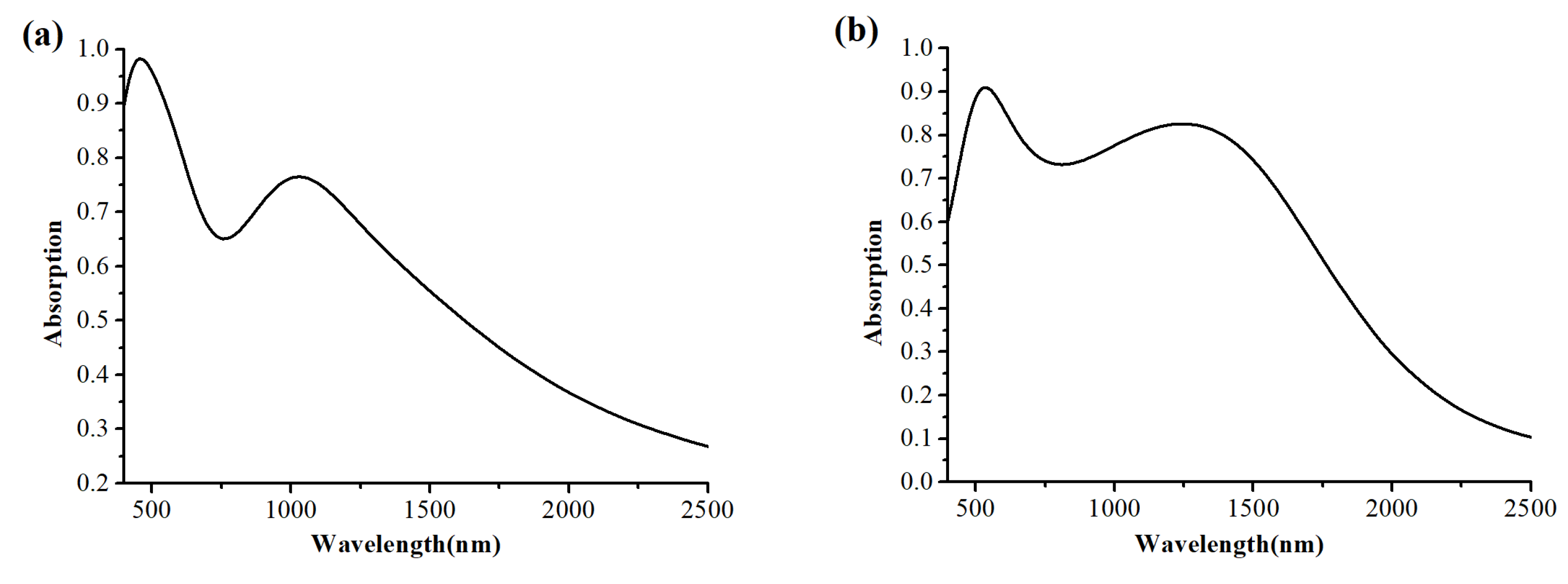

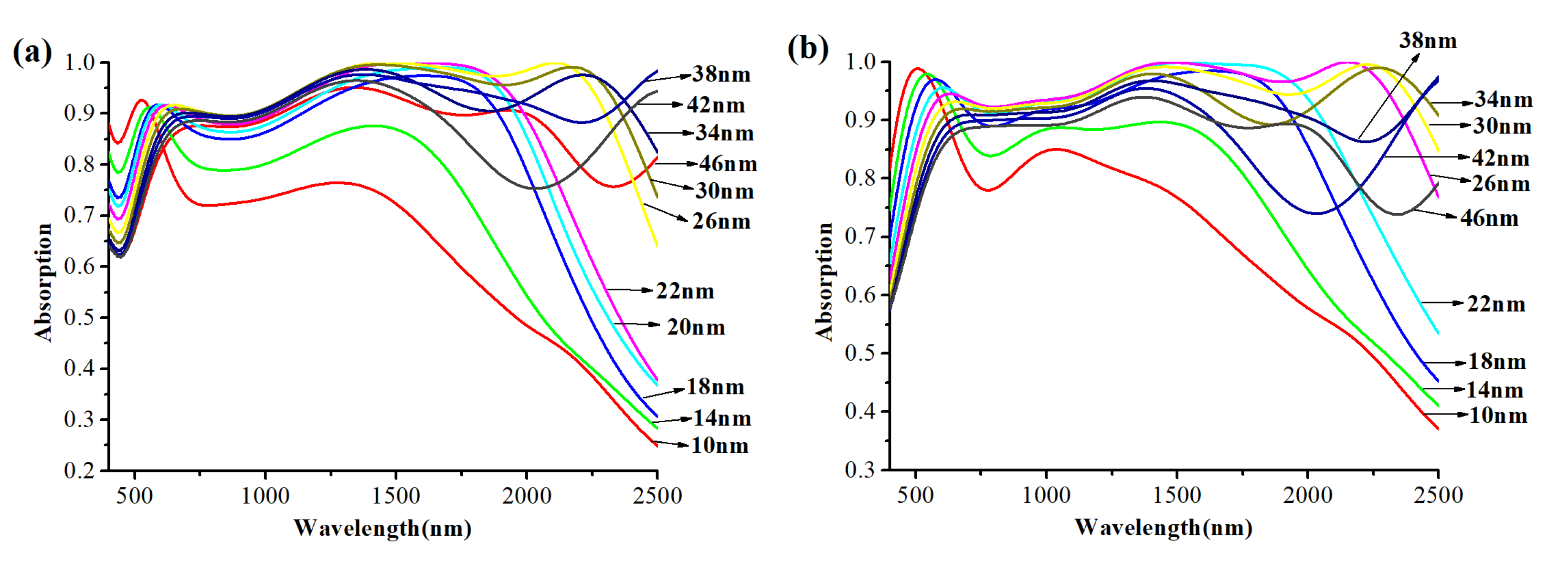
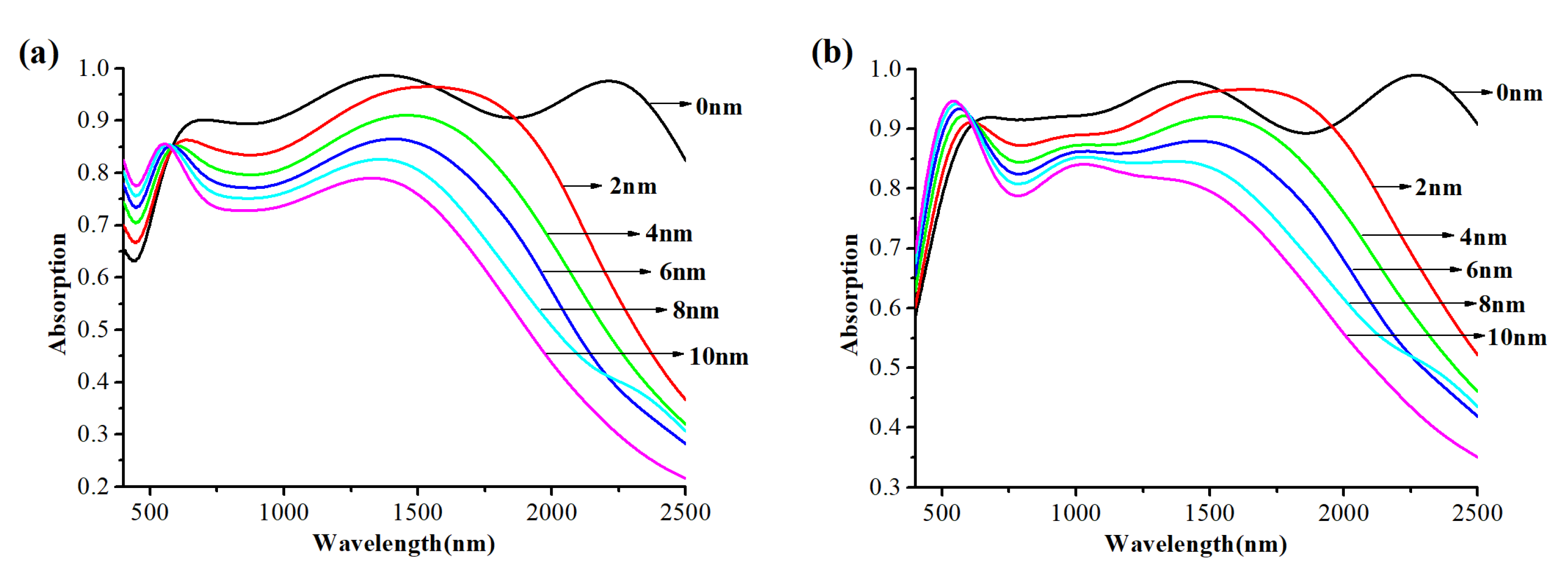

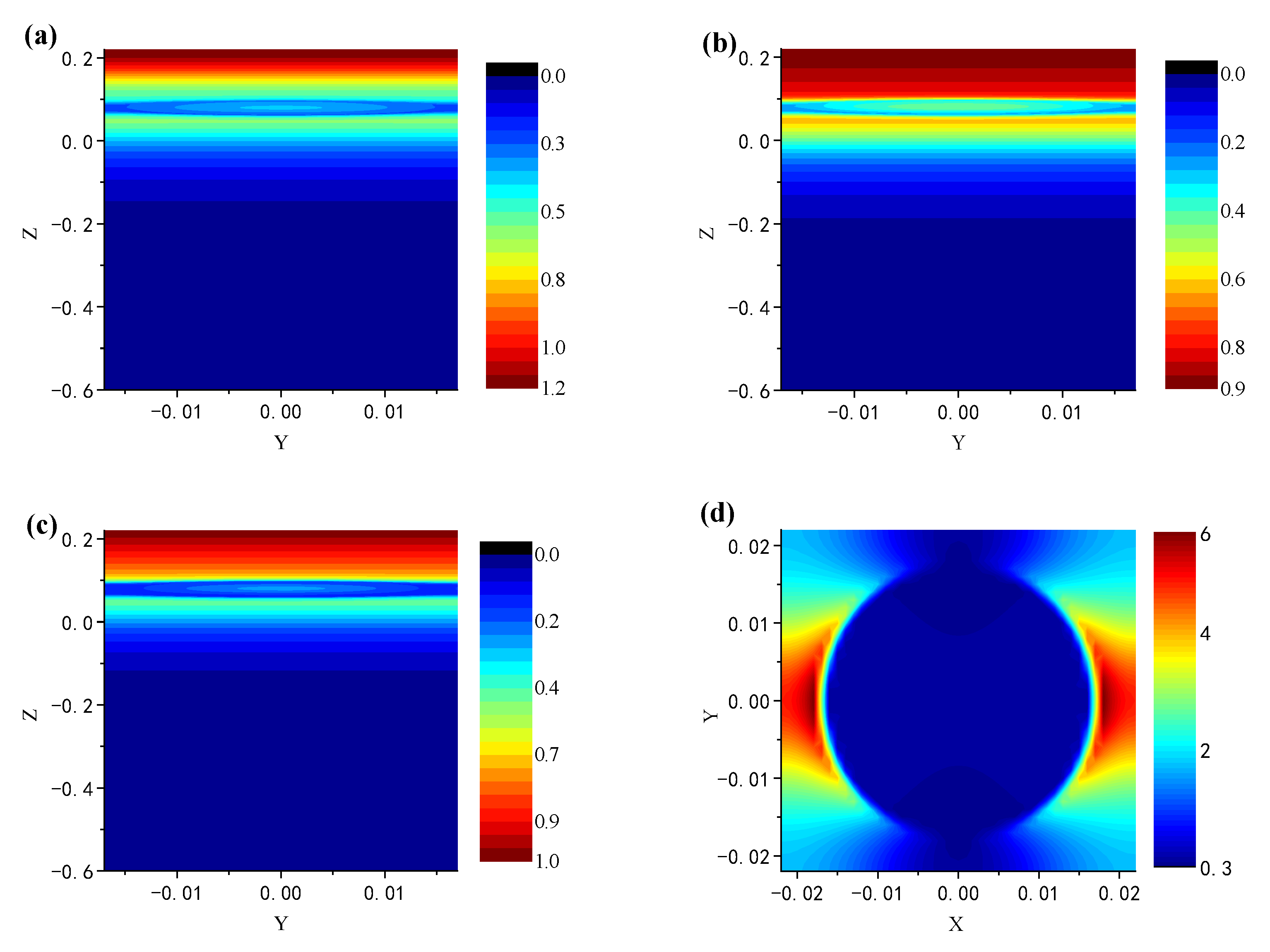
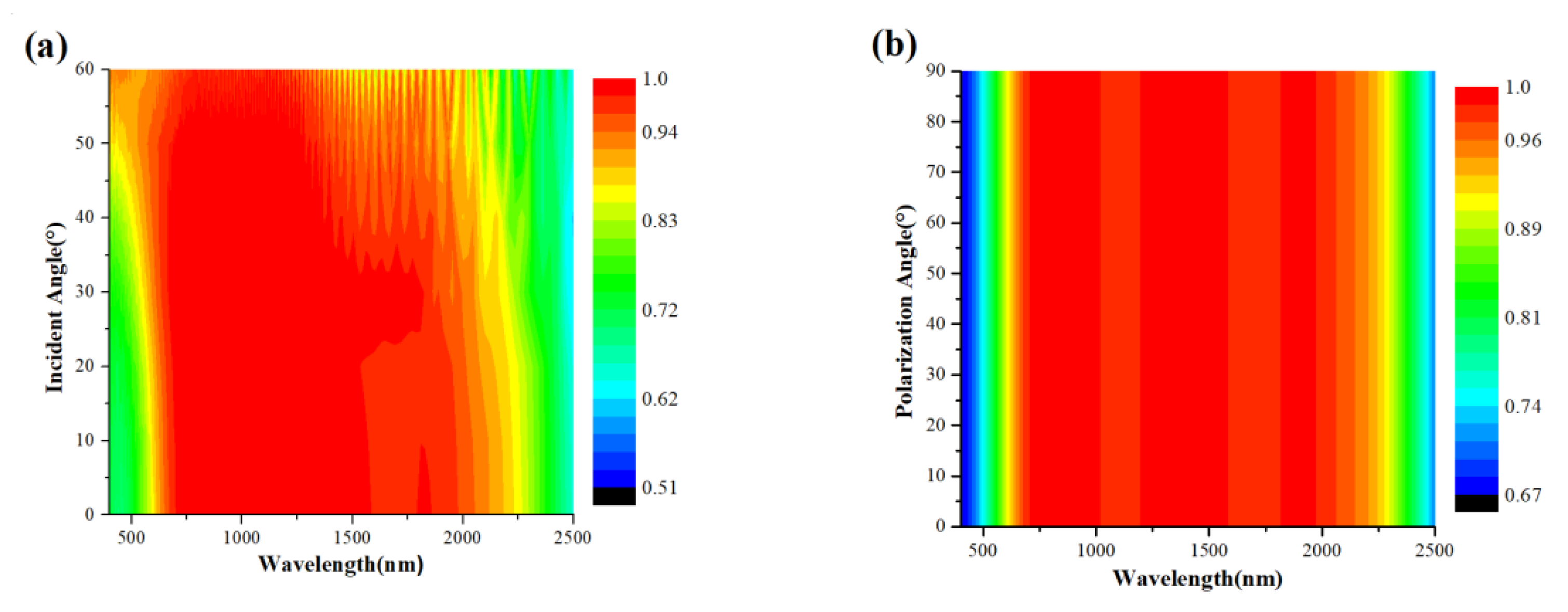
| Reference | Main Material | Absorption Bandwidth | Absorption Efficiency |
|---|---|---|---|
| [5] | Au and Cr | 500–1200 nm | 90% |
| [39] | MXene, Au, and Al2O3 | 600–2100 nm | 80–90% |
| [42] | MXene and Au | 500–1500 nm | about 80% |
| [43] | Tungsten | 500–2500 nm | 90% |
| [45] | SiO2-VO2-MoS2 | 800–2350 nm/800–1160 nm | 86.5%/96.6% |
| [47] | ITO | 1500–3500 nm | over 80% |
| This paper | MXene and Tungsten | 400–2500 nm | over 95% |
Publisher’s Note: MDPI stays neutral with regard to jurisdictional claims in published maps and institutional affiliations. |
© 2022 by the authors. Licensee MDPI, Basel, Switzerland. This article is an open access article distributed under the terms and conditions of the Creative Commons Attribution (CC BY) license (https://creativecommons.org/licenses/by/4.0/).
Share and Cite
Jia, Y.; Wu, T.; Wang, G.; Jiang, J.; Miao, F.; Gao, Y. Visible and Near-Infrared Broadband Absorber Based on Ti3C2Tx MXene-Wu. Nanomaterials 2022, 12, 2753. https://doi.org/10.3390/nano12162753
Jia Y, Wu T, Wang G, Jiang J, Miao F, Gao Y. Visible and Near-Infrared Broadband Absorber Based on Ti3C2Tx MXene-Wu. Nanomaterials. 2022; 12(16):2753. https://doi.org/10.3390/nano12162753
Chicago/Turabian StyleJia, Yang, Tong Wu, Guan Wang, Jijuan Jiang, Fengjuan Miao, and Yachen Gao. 2022. "Visible and Near-Infrared Broadband Absorber Based on Ti3C2Tx MXene-Wu" Nanomaterials 12, no. 16: 2753. https://doi.org/10.3390/nano12162753
APA StyleJia, Y., Wu, T., Wang, G., Jiang, J., Miao, F., & Gao, Y. (2022). Visible and Near-Infrared Broadband Absorber Based on Ti3C2Tx MXene-Wu. Nanomaterials, 12(16), 2753. https://doi.org/10.3390/nano12162753






